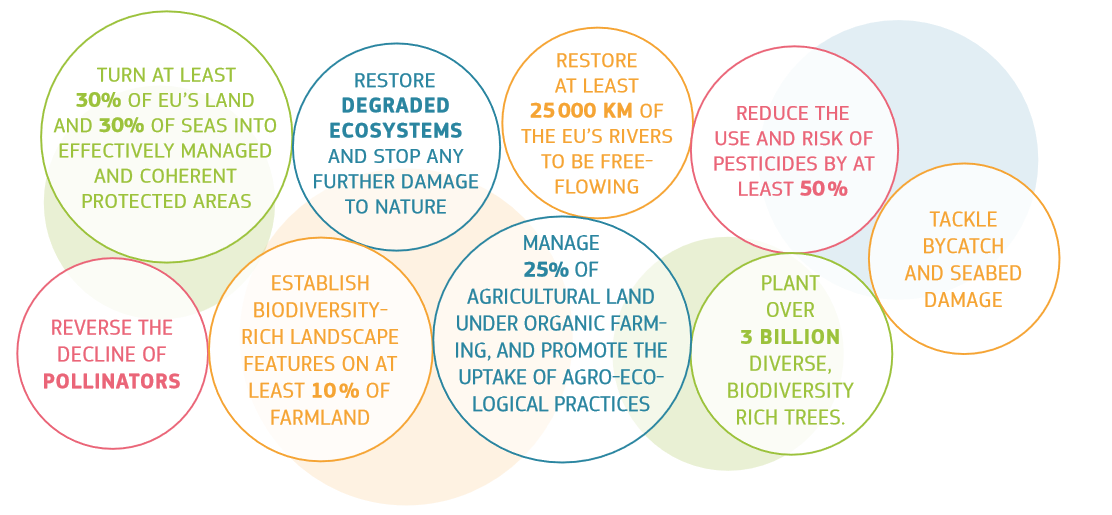SaveGREEN - In good company: SaveGREEN at the 16th EUSDR PA6 Steering Committee Meeting
26-11-2021
On 11 November, several members of the SaveGREEN project team participated in the 16th Steering Committee meeting of the EUSDR’s (EU Strategy for the Danube Region) Priority Area 6 (PA6). The meeting centered around the key topic of ‘Ecological Connectivity in the Danube Region’ and featured a keynote address by Stefan Leiner, Head of the Biodiversity Unit of the European Commission’s DG Environment, followed by the presentation of 5 projects, each dealing with ecological connectivity and giving a unique perspective on on-going efforts to counter habitat fragmentation and biodiversity loss in the Danube region.

Image 1.: Opening of the meeting by PA6 Coordinators Ana Kobaslic and Florian Ballnus © EUSDR PA 6
The EUSDR PA6 focusses on ‘Biodiversity, Landscapes, and Air and Soil Quality’ and is one of the 12 priority areas of the EUSDR. Together with PA4 ‘Water Quality’ and PA5 ‘Environmental Risks’, it forms the second pillar of the Strategy on ‘Protecting the Environment’. The work of the PA6 is governed by 6 overarching targets:
Improve management of Natura 2000 sites and other protected areas through transnational cooperation and capacity building
Strengthen the efforts to halt the deterioration in the status of species and habitats occurring in the Danube Region and covered by EU nature legislation and in particular to continue the ongoing work and efforts to securing viable populations of Danube sturgeon species
Reduce the introductions and spread of Invasive Alien Species (IAS) in the Danube Region
Maintain and restore Green and Blue Infrastructure elements through integrated spatial development and conservation planning
To improve and/or maintain the soil quality in the Danube Region
To decrease air pollution in the Danube Region
The close thematic and geographic overlap of the work of the SaveGREEN project and the activities of the EUSDR PA6 make the SaveGREEN consortium an important and valuable partner for the effective implementation of the EU Strategy in the Danube Region.
The challenges linked to the ongoing Covid-19 crisis have in recent months moved the PA6 to hold more regular Steering Committee meetings in which they shine a light on specific thematic clusters in their work. In November, the topic was ‘Ecological Connectivity in the Danube Region’, and the possibility to attend as well as to present was opened, not only to members and observers of the PA6, but to external guests as well – an opportunity which the SaveGREEN team was eager to seize.
The meeting was opened by a keynote address by the Head of the Biodiversity Unit of the European Commission’s DG Environment, Stefan Leiner. In his address, Mr. Leiner highlighted the role of ecological connectivity in the context of the EU Biodiversity Strategy for 2030, underlining the critical importance of habitat continuity and countering fragmentation for the conservation of biodiversity in Europe.
 Image 2.: Targets of the 2030 EU Biodiversity Strategy © EU Commission (link to publication)
Image 2.: Targets of the 2030 EU Biodiversity Strategy © EU Commission (link to publication)
The keynote was followed by Michael Huber, E.C.O. Institute of Ecology, who presented the results of a 2018 study on ecological connectivity in the Danube region commissioned by the PA6. The study identified 5 main gaps and challenges for connectivity work in the Danube region: 1) Research and knowledge gaps; 2) Cooperation gaps; 3) Institutional gaps; 4) Communication gaps, and 5) Spatial gaps. The full study is available here.
After this setting of the scene, 5 projects were presented, each dealing with ecological connectivity from another perspective. The first was the MEASURES project on ‘Managing and restoring aquatic ecological corridors for migratory fish species in the Danube river basin’, presented by Thomas Friedrich of the Institute of Hydrobiology and Aquatic Ecosystem Management of the BOKU University, Vienna. This was followed by LIFE WILDisland Initiative, presented by Georg Frank, Danubeparks, National Park Donau Auen, which looks at islands in the Danube as semi-terrestic ecological stepping stones.
Video 1.: lifeline MDD Project Introduction Video ©lifeline MDD
Kerstin Böck from WWF Austria presented the third project, lifeline MDD, on ‘Protecting and restoring ecological connectivity in the Mura-Drava-Danube river corridor through cross-sectoral cooperation’. The fourth presentation was on D2C DaRe to Connect project on ‘Supporting the Danube Region’s ecological connectivity by linking Natura 2000 areas along the Green Belt’. The project’s results and conclusions were summarised by Martin Kuba, Department Green Belt of the German BUND.
The final project presentation was held by Cristian-Remus Papp, WWF Romania, in which he shone a light on the activities of the SaveGREEN project and its predecessor ConnectGREEN, which just came to an end in October. Mr. Papp highlighted some of the valuable outputs of ConnectGREEN, including a Map of Ecological Connectivity in the Carpathians, a Methodology for the Identification of Ecological Corridors, and an International Action Plan on the Conservation of Large Carnivores and Ecological Connectivity (available here), and how SaveGREEN picks up where ConnectGREEN left off.
Together with the Secretariat of the Carpathian Convention, Mr. Papp and SaveGREEN’s Lead Coordinator, Hildegard Meyer, outlined a proposal for a collaboration between the EUSDR PA6, the Carpathian Convention, and the SaveGREEN Consortium, centred around the drafting of a Joint Declaration on Ecological Connectivity in the Danube-Carpathian Region. After a brief discussion, it was agreed to further pursue this proposal in close collaboration.
The event with three sessions that offered conclusions and an outlook after the morning’s presentations and exchanges. Siegfried Geissler, Landratsamt Neuburg-Schrobenhausen, offered some conclusions based on experiences with the Masterplan Living Space Bavarian Danube and was followed by Edith Hödl, who shared the view on ecological connectivity held by the International Commission for the Protection of the Danube River (ICPDR).
Subscribe to our newsletter here or follow our social media channels on Facebook and Twitter to stay updated to gain project insights! Save nature: SaveGREEN!
Author:
Christophe Janz, WWF-CEE
Contributed by Hildegard Meyer, WWF-CEE
